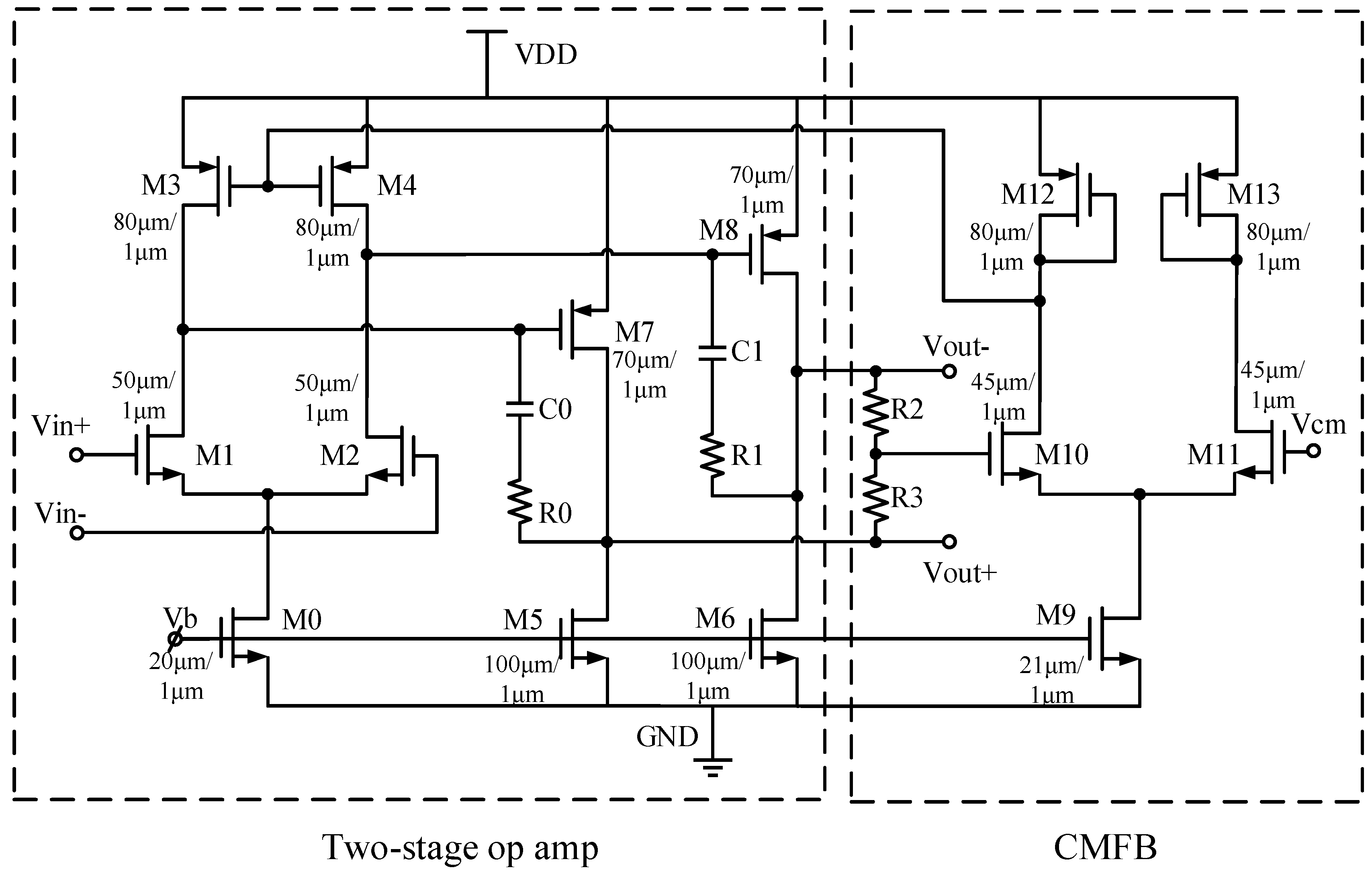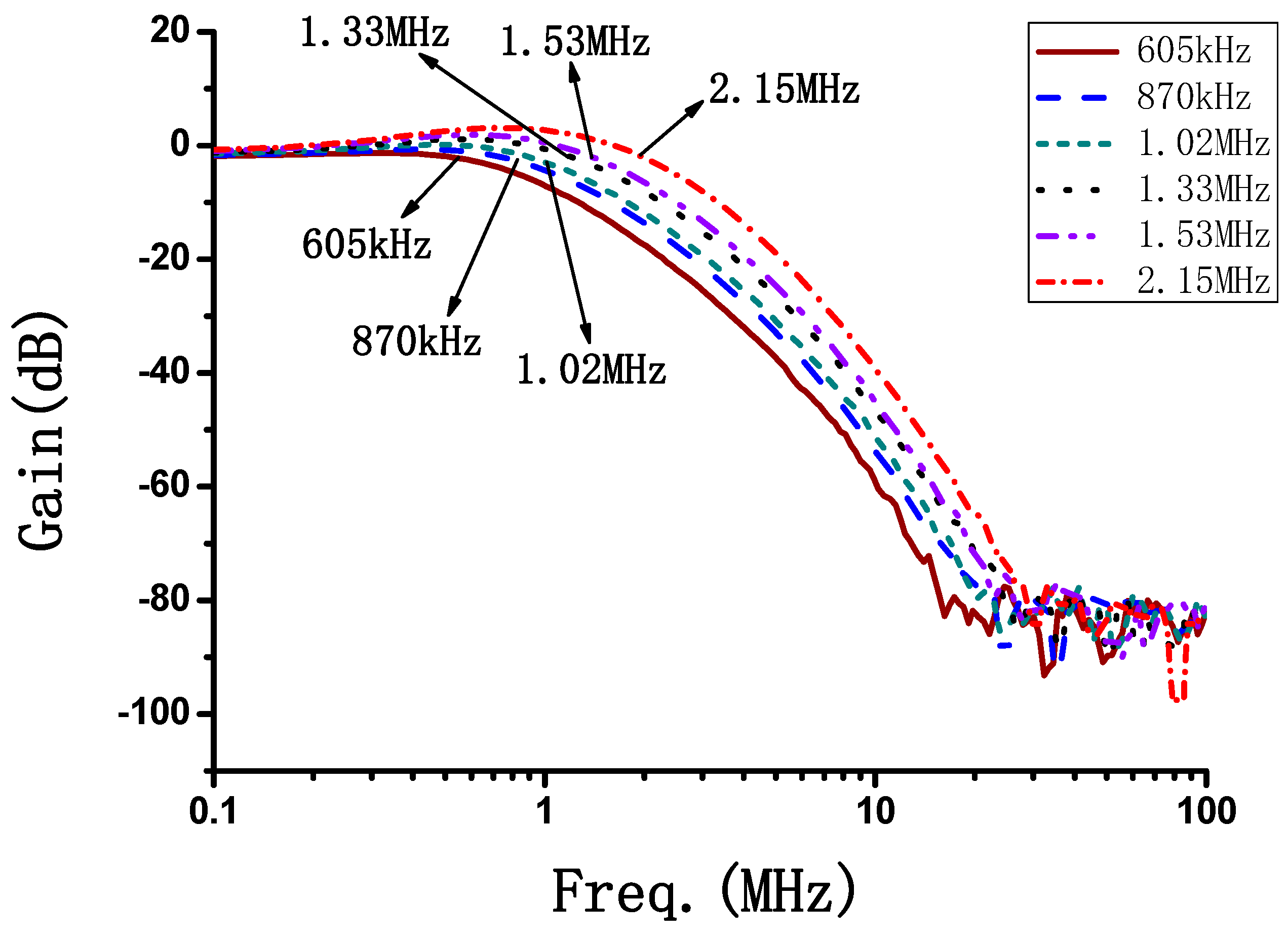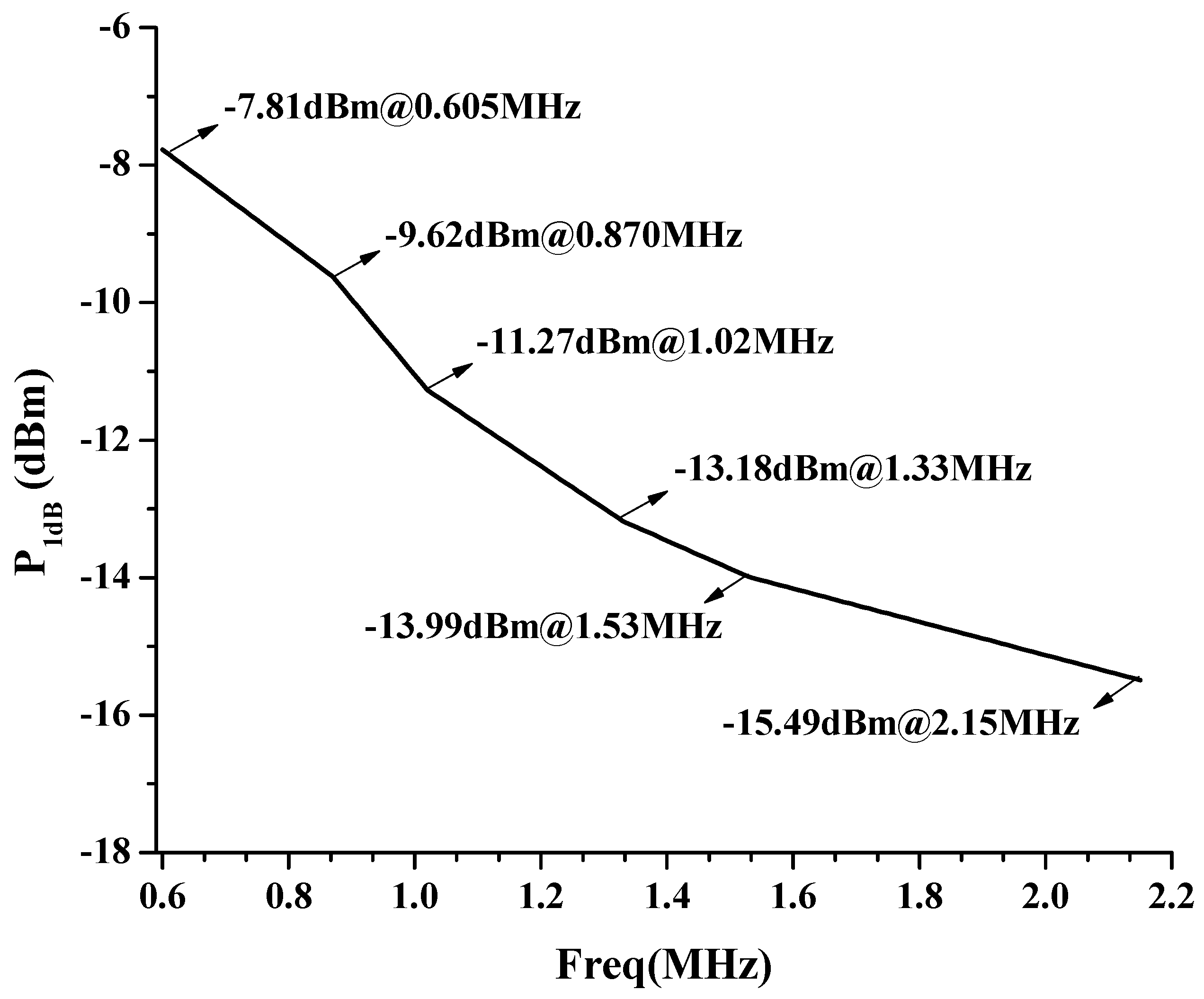A CMOS Programmable Fourth-Order Butterworth Active-RC Low-Pass Filter
Abstract
:1. Introduction
2. Circuit Design
3. Measurement Results
4. Conclusions
Author Contributions
Funding
Conflicts of Interest
References
- Bhattacharyya, M.; Gruenwald, W.; Jansen, D.; Reindl, L.; Aghassi-Hagmann, J. An Ultra-Low-Power RFID/NFC Frontend IC Using 0.18 μm CMOS Technology for Passive Tag Applications. Sensors. 2018, 18, 1452. [Google Scholar] [CrossRef] [PubMed] [Green Version]
- Scherhaufl, M.; Pichler, M.; Stelzer, A. UHF RFID Localization Based on Phase Evaluation of Passive Tag Arrays. IEEE Trans. Instrum. Meas. 2015, 64, 913–922. [Google Scholar] [CrossRef]
- Ghahremani, A.; Rezaei, V.D.; Bakhtiar, M.S. A UHF-RFID Transceiver with a Blocker-Canceller Feedback and +30 dBm Output Power. IEEE Trans. Circuits Syst. I Regul. Pap. 2013, 60, 3043–3054. [Google Scholar] [CrossRef]
- Kipnis, I.; Chiu, S.; Loyer, M.; Carrigan, J.; Rapp, J.; Johansson, P.; Westberg, D.; Johansson, J. A 900MHz UHF RFID Reader Transceiver IC. In Proceedings of the IEEE International Solid-State Circuits Conference, San Francisco, CA, USA, 11–15 February 2007; pp. 214–598. [Google Scholar] [CrossRef]
- Phan, A.T.; Farrell, R.; Lee, J.; Lee, S.-G. 380 MHz low-power sharp-rejection active-RC LPF for IEEE 802.15.4a UWB WPAN. In Proceedings of the IEEE International Symposium on Circuits and Systems, Taipei, Taiwan, 24–27 May 2009; pp. 1369–1372. [Google Scholar] [CrossRef] [Green Version]
- Li, S.; Chen, L.; Zhao, Y. Reconfigurable Active-RC LPF with Self-Adaptive Bandwidth Calibration for Software-Defined Radio in 130 nm CMOS. In Proceedings of the 2018 14th IEEE International Conference on Solid-State and Integrated Circuit Technology (ICSICT), Qingdao, China, 31 October–3 November 2018; pp. 1–3. [Google Scholar] [CrossRef]
- Duan, L.; Chen, G.; Ma, R.; Cao, M.; Chi, B. A Highly Linear 0.9V 3rd-Order Acitve-RC Low-Pass Filter in 28nm CMOS. In Proceedings of the 2019 IEEE International Conference on Electron Devices and Solid-State Circuits (EDSSC), Xi’an, China, 12–14 June 2019; pp. 1–2. [Google Scholar] [CrossRef]
- Ye, L.; Shi, C.; Liao, H.; Huang, R.; Wang, Y. Highly Power-Efficient Active-RC Filters with Wide Bandwidth-Range Using Low-Gain Push-Pull Opamps. IEEE Trans. Circuits Syst. I Regul. Pap. 2013, 60, 95–107. [Google Scholar] [CrossRef]
- Wu, W.; Mo, T.; Lu, Z. A 180nm CMOS three stage feedforward compensation op-amp with linearity improvement technique for active RC LPF. In Proceedings of the 2016 10th IEEE International Conference on Anti-counterfeiting, Security, and Identification (ASID), Xiamen, China, 23–25 September 2016; pp. 91–95. [Google Scholar] [CrossRef]
- Jin, X.; Dai, F.F.; Xin, J. A 6th order zero capacitor spread 1MHz-10MHz tunable CMOS active-RC low pass filter with fast tuning scheme. In Proceedings of the IEEE International Symposium on Circuits and Systems (ISCAS), Seoul, South Korea, 20–23 May 2012; pp. 1187–1190. [Google Scholar] [CrossRef]
- Li, Y.; Wang, Y. A 5th-Order Butterworth Active-RC Complex Band-pass Filter with New Passive Compensation. In Proceedings of the 2018 14th IEEE International Conference on Solid-State and Integrated Circuit Technology (ICSICT), Qingdao, China, 31 October–3 November 2018; pp. 1–3. [Google Scholar] [CrossRef]
- Laouej, D.; Daoud, H.; Loulou, M. Design of sixth order butterworth Gm-C filter using Particle Swarm Optimization program for biomedical application. In Proceedings of the 29th International Conference on Microelectronics (ICM), Beirut, Lebanon, 10–13 December 2017; pp. 1–5. [Google Scholar] [CrossRef]
- Meghdadi, M.; Bakhtiar, M. Analysis and Optimization of SFDR in Differential Active-RC Filters. IEEE Trans. Circuits Syst. I Regul. Pap. 2012, 59, 1168–1177. [Google Scholar] [CrossRef]
- Filanovsky, I.M. Filters with monotonic amplitude-frequency response. In Proceedings of the 1998 Midwest Symposium on Circuits and Systems, Notre Dame, IN, USA, 9–12 August 1998; pp. 436–439. [Google Scholar] [CrossRef]
- Kamat, D.V.; Mohan, P.V.A.; Prabhu, K.G. Active-RC filters using two-stage OTAs with and without feed-forward compensation. IET Circuits Devices Syst. 2011, 5, 527–535. [Google Scholar] [CrossRef]
- Zheng, H.; Luong, H.C. A 36/44 MHz Switched-capacitor Bandpass Filter for Cable-TV Tuner Application. In Proceedings of the 2006 IEEE Asian Solid-State Circuits Conference, Hangzhou, China, 13–15 November 2006; pp. 235–238. [Google Scholar] [CrossRef]
- Ravindran, A.; Savla, A.; Younus, I.; Ismail, M. A 0.8V CMOS filter based on a novel low voltage operational transresistance amplifier. In Proceedings of the 45th Midwest Symposium on Circuits and Systems, Tulsa, OK, USA, 4–7 August 2002; Volume III. [Google Scholar] [CrossRef]
- Mahattanakul, J.; Chutichatuporn, J. Design Procedure for Two-Stage CMOS Opamp with Flexible Noise-Power Balancing Scheme. IEEE Trans. Circuits Syst. I Regul. Pap. 2005, 52, 1508–1514. [Google Scholar] [CrossRef]
- Wang, W.; Yan, N.; Min, H. A wide tuning range Active-RC filter for multi-mode applications. In Proceedings of the 10th IEEE International Conference on Solid-State and Integrated Circuit Technology, Shanghai, China, 1–4 November 2010; pp. 336–338. [Google Scholar] [CrossRef]
- Huang, J.; Wen, J.; Lai, Y.; Liu, R. Chip design of an 8 MHz CMOS switched-capacitor low-pass filter for signal receiver applications. In Proceedings of the 2010 3rd International Congress on Image and Signal Processing, Yantai, China, 16–18 October 2010; pp. 4037–4041. [Google Scholar] [CrossRef]
- Hori, S.; Maeda, T.; Yano, H. A widely tunable CMOS Gm-C filter with a negative source degeneration resistor transconductor. In Proceedings of the 29th European Solid-State Circuits Conference, Estoril, Portugal, 16–18 September 2003; pp. 449–452. [Google Scholar] [CrossRef]
- Chen, G.; Li, Z.; Su, H.; Zhang, L.; Li, W. A 5th-order Chebyshev active RC complex filter with automatic frequency tuning for wireless sensor networks application. In Proceedings of the International Symposium on Signals, Systems and Electronics, Nanjing, China, 17–20 September 2010; pp. 1–4. [Google Scholar] [CrossRef]
- Huang, J.; Wen, J.; Lin, Y. Chip design of a 10-MHz switched capacitor low-pass filter for wireless application. In Proceedings of the 2014 Sixth International Conference on Wireless Communications and Signal Processing (WCSP), Hefei, China, 23–25 October 2014; pp. 1–5. [Google Scholar] [CrossRef]










| Ref. | [21] | [22] | [23] | [20] | This Work |
|---|---|---|---|---|---|
| Tech./nm | 180 | 180 | 180 | 180 | 180 |
| Supply(V) | 1.8 | 1.8 | 1.8 | 1.8 | 1.8 |
| Filter order | 6 | 5 | 5 | 5 | 4 |
| Power(mW) | 15 | 11.7 | 18 | 44.2 | 12.6 |
| fc(MHz) | 1.5—12 | 0.52—3 | 10.2 | 8.72 | 0.605—2.15 |
| Area(mm2) | 0.83 | 0.85 | 0.41 | 0.90 | 0.17 |
| Atte@10 fc | 60 | 56 | 35 | 40 | 70 |
| Input-referred noise(nV/√Hz) | / | / | / | 56—146 | 9—206 |
| FOM(dB) | 17.6 | 12.2 | 16.8 | 9.45 | 18.5 |
© 2020 by the authors. Licensee MDPI, Basel, Switzerland. This article is an open access article distributed under the terms and conditions of the Creative Commons Attribution (CC BY) license (http://creativecommons.org/licenses/by/4.0/).
Share and Cite
Zhang, C.; Shang, L.; Wang, Y.; Tang, L. A CMOS Programmable Fourth-Order Butterworth Active-RC Low-Pass Filter. Electronics 2020, 9, 204. https://doi.org/10.3390/electronics9020204
Zhang C, Shang L, Wang Y, Tang L. A CMOS Programmable Fourth-Order Butterworth Active-RC Low-Pass Filter. Electronics. 2020; 9(2):204. https://doi.org/10.3390/electronics9020204
Chicago/Turabian StyleZhang, Changchun, Long Shang, Yongkai Wang, and Lu Tang. 2020. "A CMOS Programmable Fourth-Order Butterworth Active-RC Low-Pass Filter" Electronics 9, no. 2: 204. https://doi.org/10.3390/electronics9020204





